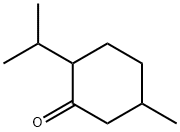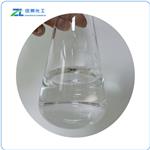Chemical Properties
Menthone exists as two stereoisomers, trans-menthone and
cis-isomenthone, each of which occurs as a pair of enantiomers, due to
the two asymmetric centers present in the molecule.
Both stereoisomers occur in many essential oils, often as a single enantiomer
species. A particularly high concentration (sometimes >50%) is found in oils from
Mentha species.Thementhones are colorless liquids that possess a typically minty
odor; the odor of isomenthone is slightly musty.They have a strong tendency to
interconvert and are, therefore, difficult to obtain in high purity. Industrial products
aremixtures of varying composition.
The menthones are converted into the corresponding menthols by means
of hydrogenation; for example, (?)-menthone yields (+)-neomenthol and
(?)-menthol.
(?)-Menthone can be obtained by distillation of dementholized cornmint oil or
by oxidation of (?)-menthol (e.g., with chromic acid). Dehydrogenation of (?)-
menthol (e.g., with copper chromite) yields a mixture of (?)-menthone and (+)-
isomenthone.
rac-Menthone is prepared analogously to rac-menthol. However, it can also be
synthesized by hydrogenation of thymol in the presence of palladium–carbon catalysts
.
Menthone and isomenthone are used for synthetic peppermint oils and bases.
Application
Menthone is used in flavor compositions, not only in Mint complexes, but in
traces in fruit blends, particularly in imitation
Raspberry, where it gives good lift and freshness in the otherwise oversweet composition. The concentration is normally about 5 to
50 ppm in the finished product.
Synthesis Reference(s)
The Journal of Organic Chemistry, 52, p. 5621, 1987
DOI: 10.1021/jo00234a021Tetrahedron Letters, 13, p. 749, 1972
General Description
Menthone is a cyclic oxygenated terpene and its antioxidant potential has been evaluated. It is one of the key active component of Danshu capsule (DSC), a medicinal compound in traditional Chinese medicine.





